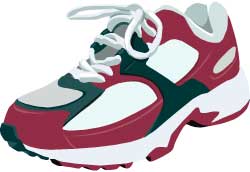 People run for many different reasons. For some, it gives them a positive energy boost, and it’s an ideal way to keep their weight in check. For others, it’s the buzz of competition, or quite simply, because they enjoy it.
People run for many different reasons. For some, it gives them a positive energy boost, and it’s an ideal way to keep their weight in check. For others, it’s the buzz of competition, or quite simply, because they enjoy it.
One of the first steps to healthy running is wearing supportive running shoes. Neglecting to wear proper footwear can lead to a variety of foot problems that can cause injury and impede performance.
To find the best running shoe, you must first determine your foot type. Are you a pronator or a supinator, or do you have neutral feet? Pronators have relatively flat feet, leading to overpronation (gait in which the ankle rolls inward excessively). Supinators have high arches, leading to underpronation (gait in which too much weight is placed on the outside of the feet). And finally, if you have neutral feet, you have a foot that is in-between a flat-foot and high arch.
For assistance in determining your foot type, consult Dr. LeBlanc. She will perform a gait analysis and provide suggestions about the best running shoe for your foot type. Taking the “wet test” is another way to determine your foot type. To take this simple test, wet the bottom of each of foot and stand normally on a paper bag. After a minute, step off and observe the imprint left by your foot.

Follow these basic guidelines for successful running shoe shopping:
- Have your feet measured while you’re standing
- Always try on both shoes and test your running shoes while still in the store
- Shop for shoes later in the day; feet tend to swell during the day
- Buy shoes that don’t pinch your toes, either at the tips, or across the toe box
- Wear or buy the socks you’ll wear when you run
- If you wear orthotics, bring them. You need to see how the shoe fits with the orthotic inside.
- People who are pronators (low/flat arch) should choose a supportive shoe designed for stability and motion control. These shoes help to correct for overpronation.
- People who have a neutral arch should choose a shoe with equal amounts of stability and cushioning to help absorb shock.
- People who are supinators (high arch) should choose a cushioned running shoe with a softer midsole and more flexibility. These features will compensate for the poor shock absorption of a high-arched foot.
If you suffer from bunions, finding the right running shoe may be a little tricky, but it can be done. Look for shoes that provide soft mesh at the sides for more comfort and cushioning, a wide toe box, and a snug heel for stability.
